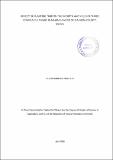| dc.description.abstract | The cowpea (Vigna unguiculata) crop is valued for its multiple uses as food, fodder, green manure, and as cover crop for conservation agriculture, weed and soil erosion control. It improves the soil fertility through nitrogen fixation and is drought tolerant and can be grown on a variety of soils and climatic conditions. The crop is of high nutritive value, but its yield in Makindu ward of Makueni County has remained low sometimes at 0.13 t/ha despite its potential yield of 1.5 t/ha. Inappropriate husbandry practices by the farmers such as untimely planting among many others partly contribute to this. An experimental study was carried out with view to investigate the effect of the timing of planting in relation to the onset of rains on the growth and yield of cowpea cultivars in the ward. The experiment was set up in a Randomized Complete Block Design (RCBD) during March-April- May, 2013 and replicated in a similar season in 2014. The treatments comprised planting at three time regimes viz. onset of rain, then one and two weeks after onset of rain. Three cowpea cultivars namely KVU 27-1, M66, and a local variety denoted as V1, V2, and V3, respectively were included in the study. Fifteen out of forty four plants in each plot was sampled out to act as representative of the total population. Data was collected weekly based on a number of growth and yield parameters, and was analyzed using SPSS version 20. The experiment revealed that the timing of planting in relation to onset of rains had significant (p<0.05) effects on the days to 50% flowering, days to physiological maturity, the height of the plants, the number of branches per plant, the number of pedicules per plant, the number of pods per plant, the number of grains per pod, the grain weight per plant, the weight of a hundred grains, the grain yield per hectare, and the above ground biomass weight. As regards the cultivars KVU 27-1 was early maturing, produced the highest number of pods per plant as well as the highest number of grains per pod. Its grain yield was 478 kgs/ha. On the other hand, although the local variety grew the shortest in height and was late maturing, it scored the best in terms of 100-seed weight, grain yield/ha (632 kgs), above ground biomass weight and even in the harvest index. Therefore, since the three varieties were subjected to similar conditions during their growth and development stages, the local is thus recommended for the farmers in Makindu ward of makueni County, Kenya. | en_US |

